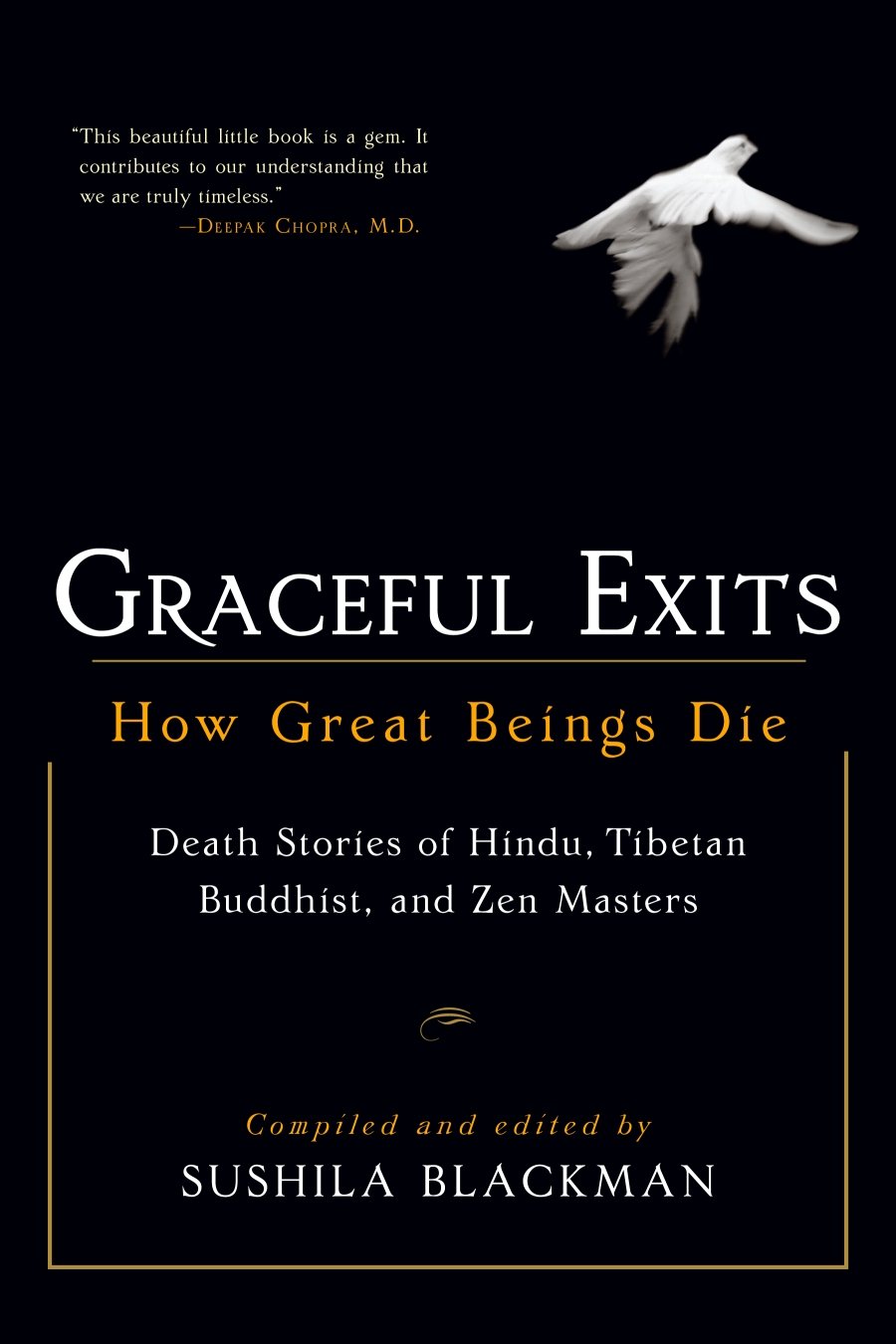GRACEFUL EXITS How Great Beings Die: Death stories of Hindu, Tibetan Buddhist and Zen Masters. Compiled and edited by Sushila Blackman
Book review
Michael Haggiag reviews a remarkable book about how spiritual masters die a good death.

Book cover
Hinduism is the parent religion of Buddhism, and the Buddha adapted its wheel of cyclical existence (bhavachakra), a beginning-less and endless round of birth, sickness, old age and death (samsara). In Hinduism the soul (atman) merges with its creator, the over-soul or Brahma (God), upon death, ascending and exiting through chakras in the head. The editor Sushila Blackman was a student of the Hindu master Swami Muktananda and she herself died of lung cancer not long after compiling and editing this book. She is conversant with the Zen and Tibetan approaches to death as well the Hindu customs and borrows stories from all three traditions. She quotes the Dalai Lama on the importance of dying in spiritual practice: “Awareness of death is the very bedrock of the path. Until you have developed this awareness, all other practices are obstructed.”
Birth is followed by death, which in turn is followed by rebirth. Seemingly separate, birth and death are two sides of the same coin. The Buddha rejected the two opposing views of death: eternalism, in which a soul lives on forever after death, and nihilism, in which death is seen as the final and complete extinction of that stream of dharma elements. He regarded both views as equally mistaken.
GRACEFUL EXITS may cover three spiritual traditions, but there is only one human Heart. The book contains three main sections: (a) an introduction with six titled sub-sections introducing the themes of the book. (b) a central section presented in no discernible order containing 108 short cases of the so-called Great Beings at the time of their death, including last words, behaviour or ritual practices, and (c) an afterward written two months before the author’s death, describing her meditations and her radiation treatment. She passed away on the 9th of November 1996, the first day of Diwali, the Festival of Lights. She writes in the afterward, “If this book serves to make the departure of even one other person more grace-filled, more filled with light, more saturated with God’s sublime love and understanding, it will have more than served its purpose.”
In her introduction Blackman touches on Zen and Tibetan approaches to death. She cites Yoel Hoffman, the author of Japanese Death Poems: “[He] tells us that while the notion of individual salvation has little place in the Japanese view of death, to the Zen Buddhist the solution to life’s enigma is to be found within one’s own mind. Hoffman aptly describes the Zen position: ‘One must purify one’s consciousness and see reality as it is, in its suchness. And pure reality, as seen through an enlightened mind, does not admit of such polarities as life and death. Enlightenment in the Zen tradition is identified with a state of natural simplicity that extends to one’s dying moments.’”
Similarly, in the main section, Blackman writes of Chogyam Trungpa Rimpoche: “[He] was one of the most important figures in the introduction of Tibetan Buddhism to the West. He died in 1987 at the age of 47, but left a lasting legacy in the form of his teachings and the community of students and practitioners that had grown up around him. ‘Birth and death are expressions of life,’ he wrote in a statement read after his death. ‘I have fulfilled my work and conducted my duties as much as the situation allowed, and now I have passed away quite happily…. On the whole, discipline and practice are essential, whether I am there or not. Whether you are young or old, you should learn the lesson of impermanence from my death.’” There are many accounts of well-known masters included in the main section including Chinese abbots, Japanese roshis and Indian siddhas from the Hindu tradition, as well as tulkus (reincarnated lamas) from Tibet, Bhutan and Nepal.
Impermanence (anicca) is one of the three marks of existence, or Signs of Being, the other two being suffering (dukkha) and no-self (anatta). As Zen master Rinzai instructed his disciples, “Having entered this world, now exit it completely. This house is not a place for staying long.” Soto Zen master Shunryu Suzuki also said: “We die and we do not die.” I came across a similar Tibetan saying a few winters ago: ‘’there is dying, but no one dies’’. It resonated with me as I was care-giving a dying client in North Yorkshire at the time. There was great dignity in his death. After being admitted to a hospice, he was allowed to return home to his farm to be with his family where he died comfortably, sitting upright in his armchair in front of a wood fire with his dog at his feet. His was certainly a graceful exit.
GRACEFUL EXITS How Great Beings Die: Death stories of Hindu, Tibetan Buddhist and Zen Masters. Compiled and edited by Sushila Blackman. Shambala, Boston & London, 2005. ISBN 978 1 59030 270 5. pp. 159. $14.95.




